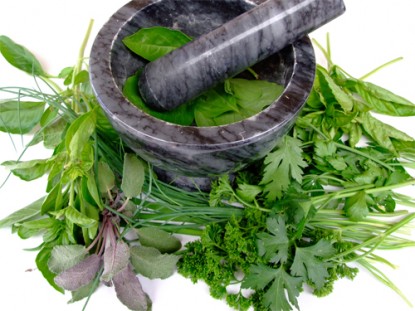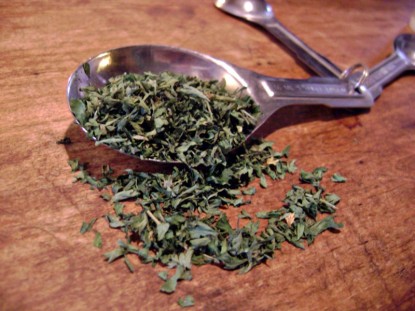Using herbs and spices in your dishes is a great way to give them a boost. I’ve always had a problem of knowing which herb to use with what dish. One of Mom’s old cookbooks had a list of different herbs and spices and which dishes to use them in. I typed a “cheat sheet” of the herbs and spices that I could find easily and now keep it in the kitchen drawer. The more I use them, the more I don’t need my handy “cheat sheet”.
Experiment with them — start with maybe 1/4 teaspoon at a time, taste and adjust to your liking. If you’re using fresh herbs, use 3 times the amount of dried herbs.

Basil
Sweet warm flavor with an aromatic odor, used whole or ground. Good with lamb, fish, roast, stews, ground beef, vegetables, dressing and omelets.
Bay Leaves
A pungent flavor, use whole leaf but remove before serving. Good in vegetable dishes, fish and seafood, stews and pickles.
Caraway
Has a spicy smell and aromatic taste. Good in cakes, breads, soups, cheese and sauerkraut.
Chives
Sweet mild flavor of onion. Good in salads, fish, soups and potatoes.
Curry Powder
A blend of spices — generally coriander, turmeric, cumin, fenugreek, and red pepper. Good in meats, poultry, fish and vegetables.
Dill
Both seeds and leaves of dill are flavorful. Leaves may be used to garnish or cook with. Good in fish, soup, dressings, potatoes, beans and dill pickles.
Ginger
A pungent root and aromatic spice. Good in pickles, preserves, cakes, cookies, soups and meats.
Marjoram
Good in fish, poultry, omelets, lamb, stew, stuffing and tomato juice.
Mint
Aromatic with a cool flavor. Good in beverages, fish, cheese, lamb, soup, peas, carrots and fruit desserts.
Oregano
Strong aromatic odor, use whole or ground. Good in tomato juice, fish, eggs, pizza, omelets, chili, stew, gravy, poultry and vegetables.
Paprika
A bright red pepper. Good in meat, vegetables and soups. Use as a garnish for potatoes, salads or eggs.
Parsley
When fresh makes a great garnish. Good in fish, omelets, soup, meat and stuffing.
Rosemary
Aromatic. Good in fish, stuffing, beef, lamb, poultry, onion, eggs and bread.
Sage
Good in tomato juice, fish, omelets, beef, poultry, stuffing and biscuits.
Tarragon
Leaves have a hot taste. Good in sauces, salads, meat, poultry, tomatoes and dressings.

Farm Bell Recipes has quite a few recipes using different herbs. Find them here or here.
What kind of herbs and spices do you use regularly? How do you use them?
Print this handy “cheat sheet” here and keep it in your kitchen drawer for easy access!
See all the Cookery 101 posts and the Herbs & Spices posts.
Cindy blogs at Chippewa Creek ~ Our Life Simplified.Interested in contributing a guest post to the Farm Bell blog? Read information here for Farm Bell blog submissions.
Want to subscribe to the Farm Bell blog? Go here.



judydee says:
If your not sure about the taste of a new herb, you can mix a small amount in with some cream cheese or butter and put it on a cracker. That way you can get an idea of how the herb tastes to see if you like it.
On November 10, 2010 at 6:15 am
rileysmom says:
Thank you CindyP! That’s a handy guide!
I like to use spices, but if it was up to me, everything would have lots of basil in it or on it!!
On November 10, 2010 at 2:01 pm
rosemary+++ says:
For me it is a matter of personal pride to raise and dry many of the herbs that I use such as basil thyme etc. Love those old cookbooks I have two cookbooks that list the use for different herbs in cooking.
On November 10, 2010 at 3:38 pm
Barbee says:
I’ve never used a lot of herbs. I think your list is going to be very helpful. Part of my problem is: I don’t know when to add them to what I am cooking – like: do I add them at the beginning, or near the end of cooking time… or somewhere in the middle. I grew thyme this year and dried some that hangs in my kitchen. I’ve never used it.
On November 10, 2010 at 4:37 pm
AnnieB says:
That’s a great list, CindyP!
I’ve raised my own herbs for many years. Most of them I prefer fresh. The only ones I like to dry are oregano, thyme, and bay leaves.
Barbee, when to add herbs depends pretty much on whether you use dried or fresh. Fresh herbs should *always* be added right at the end of cooking. They really shouldn’t be cooked at all. Dried herbs benefit from some simmering, though, although if you simmer them for much more than an hour they’ll lose their flavor somewhat. Hope this helps!
On November 10, 2010 at 5:35 pm
AnnieB says:
Oh, and I forgot . . . one of my favorite flavor combos is fresh tarragon with fresh asparagus. The neat thing is, they both come up at the same time of year! Good planning from above ?
On November 10, 2010 at 5:38 pm
whaledancer says:
When I was a teenager and trying to teach myself to cook, the only main dish I really knew how to fix was meatloaf, so when I decided to learn how to cook with herbs, each time I made meatloaf I added a different herb. And I wasn’t subtle about it, either; I wanted to really taste the herb, so I added a lot. I can’t really recommend that method, because we ate some pretty peculiar meatloaves there for a while! My mom didn’t care as long as she didn’t have to cook it. And it did work: I got a kind of sense memory of the different herbs, so that today I can taste a dish and say “Hmmm, it could use a little majoram,” (or coriander, or whatever). I think judydee’s tip might be a pleasanter way to achieve the same goal, though.
I use a lot of herbs are spices in my cooking. I’m not sure which I use most. Probably rosemary, thyme, oregano, coriander, dill, pepper, basil, nutmeg. And does garlic count? I use lots of garlic.
PS I like dill weed on cooked carrots. Or sometimes pumpkin pie spice.
On November 10, 2010 at 7:24 pm
Barbee says:
AnnieB, yes, thank you, that does help… a lot.
On November 10, 2010 at 11:17 pm
AspenFlower says:
I found this information very helpful as I’m planning on creating my first herb garden soon! Once this rain ends, that is.
On May 18, 2011 at 3:24 am